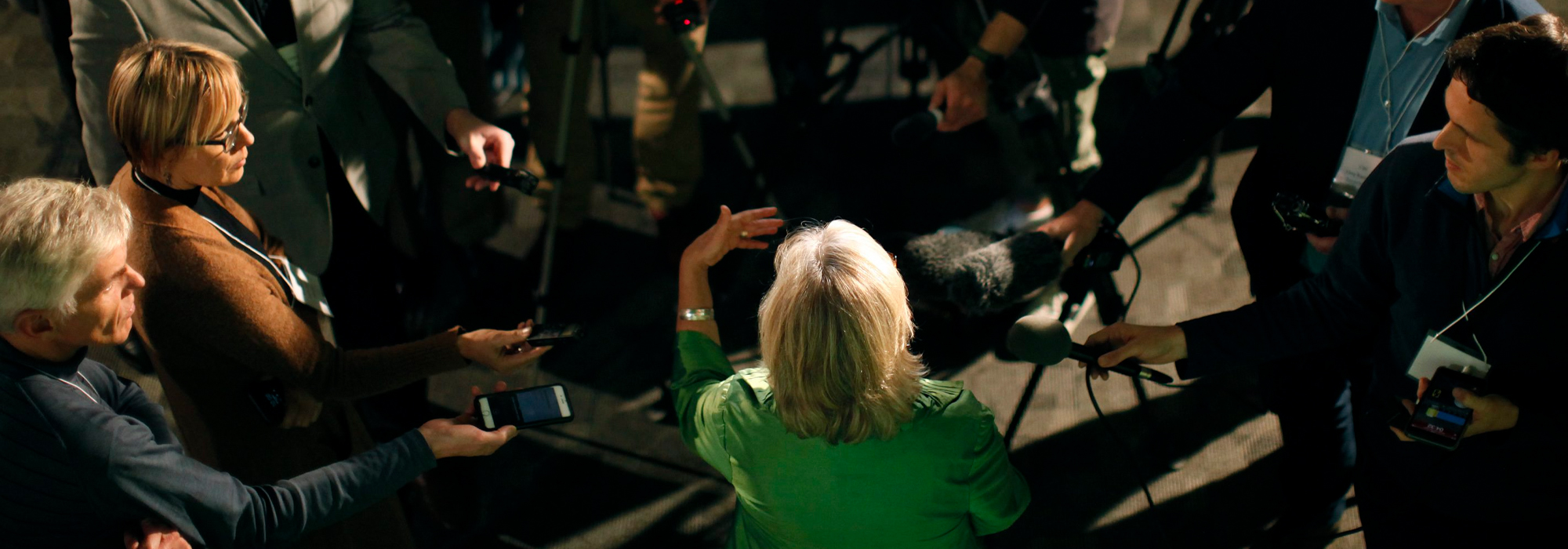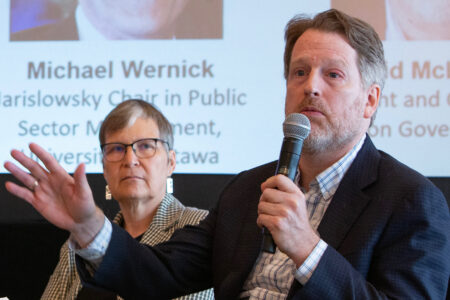
A political party’s director of communications promotes and protects the party brand, ensuring the vision, mission, and policies of a party align with its corporate identity and brand ethos, which itself “evokes emotional connections to specific images and stimulates loyalty among target audiences.” Yet even the most carefully crafted communication strategy cannot always overcome structural components that influence an election outcome, such as strategic voting.
The communications director must frame the content of the electoral platform, ensuring campaign commitments are attractive and understandable, while reflecting the party’s brand image and expressing the world views commonly associated with the party. More specifically, the director must embed and anchor election commitments – and the party vision – in an overarching communication strategy for a national political campaign. This strategy will serve as the backbone for a slogan and key messages, based on the general theme of the campaign. Various iterations of the key messages are then created to cater to different segments of the electorate. With this communication strategy, the director targets voters as well as secondary audiences, such as party members, who must be mobilized and invested in the campaign: critical efforts will thus pinpoint their queries and grievances. This remains true even if technological practices have become paramount for fundraising.
Drafting the communication strategy
The communications director starts drafting the communication strategy a few months before the election. The strategy takes into account lessons learned during the previous campaign, information gathered during the political term, and themes likely to take centre stage during the campaign. The campaign slogan is generally chosen one or two months before the launch, followed by key messages developed internally with key stakeholders – the leader, deputy leaders, cabinet members, senior staff and the campaign working group (which includes the campaign manager and deputies, director of communications, executive director and the policy director).
A fundamental goal of the communication strategy is media reach, which begins with advertising through traditional media (television, radio, print, billboards and transit advertising). With a media placement agency, the director of communications, the national campaign manager and other senior campaign team members plan media buys, often optimizing spending by focusing on districts where the party has strong chances to achieve political gains. Social media and other digital advertising platforms are also firmly entrenched in election campaign strategies.
As the election campaign approaches, the communications director hires short-term contract personnel for tasks including graphic design, video editing, social media content, writing and editing. At all times, the director works closely with the senior campaign management team (i.e. national campaign manager and deputy managers). That team, with the leader’s input, devises the campaign calendar, an essential component including the timing and location of the campaign launch, platform launch, and policy announcements.
The director of communications determines the outreach strategy and main talking points for various announcements and specific material for each campaign promise (e.g. fact sheets and press releases) is finalized as the campaign unfolds, allowing for adjustments when needed. Scheduling must also take into account the particular interests of voters in each electoral district, media availability, and the party leader’s itinerary. Yet, it must remain flexible enough to handle unforeseen events and seize opportunities as campaigning evolves.
Adapting the strategy to the news cycle
The pace for a national campaign director of communications accelerates once the campaign is officially launched. Traditionally, the position is based in party headquarters for most of the campaign, so the director can collaborate closely with the team that accompanies the leader on tour. The person ensuring the leader’s interaction with the media also liaises with headquarters to gather strategic feedback on the campaign. This allows the director of communications to collect insights and adapt key messages accordingly.
While the overall election communication strategy is developed in advance of the campaign, a daily policy message – also known as a script message – is determined for every campaign day. The national campaign manager and the director of communications generally agree on this message the day before, depending on the schedule of campaign events and announcements.
Everyone must be ready to adapt quickly to the unfolding reality of the news cycle. The big challenge is maintaining focus and staying on message while working with campaign management and the rapid response team – the war room – to deal with negative stories generated by opposition research supplied to the media. These attacks could relate to offensive or embarrassing actions or words by party leaders, or inappropriate social media content posted by otherwise unknown candidates. Their opponents go to great lengths to identify and capitalize upon any missteps – to generate negative media coverage about the opposing party, potentially eroding public support, while forcing that party and its leader to expend precious time and effort responding.
Research shows that negativity in political campaigns can increase voter turnout, depending on timing and circumstances. The team must determine in each instance whether and how the party should respond, knowing a response could fan the flames. In urgent situations, there is no time to follow chain of command, and the highest-ranking available person in the campaign hierarchy can be asked to make an immediate decision on the response. The director of communications must ensure that the response is communicated externally, via the media; and internally to staff, candidates and their campaign teams by sending them timely information and talking points for local enquiries. Through all this, the communications team must make every effort to ensure that these frustrating episodes do not impede delivery on the objectives of the campaign communications strategy.
Another task of the director of communications during the campaign is to collaborate with the digital manager to reach out to the party’s supporters through social media platforms. Digital platforms offer a dynamic range of messaging options, from posts that simply reinforce the daily platform announcement or key messages; to short videos (either custom-made or shared from other sources); to memes of various kinds. The digital manager routinely shares and retweets content from the social media feeds of the leader and other supportive individuals and organizations.
Finally, the communications director works with local campaigns to ensure their activities are consistent with the national campaign and the party brand. The director works closely with candidates, local campaign directors and campaign communications leads, sharing the latest updates about the national campaign and providing them with tools and the best advice to increase their efficiency – for instance, proposing design templates for signs and brochures and advice on local advertising and media outreach. The director of communications also prepares a series of visual assets designed for digital media tactics, along with guidelines on what to post, when, and how often. Instructions are provided on how to respond and when to ignore online trolls or unfavourable comments. Yet, for the most part, day-to-day management of local campaigns remains local – aside from key ridings, where the national communication team is more deeply involved in matters of campaign materials, messaging and strategy.
Rolling with the campaign punches
For the director of communications, the overall tone of the election campaign can present both opportunities and obstacles. The infamous 1993 quote of former prime minister Kim Campbell – “an election is no time to discuss serious issues” – could have been the shared slogan of the main parties of the 2019 campaign. Veteran political commentators said 2019 was among the nastiest campaigns in memory and bemoaned the fact that the relentless attacks and counter-attacks left little room for serious discussion on issues and policy. The parties blamed each other but there was plenty of blame to go around.
Like other parties, the Green Party had to deal with controversies, primarily the product of meticulous opposition research into its candidates’ social media histories going back a decade or more. A few candidates withdrew from the election and were replaced by the party; but most of them apologized, disavowed past positions and resumed campaigning. As Winston Churchill put it: “Politics are almost as exciting as war and quite as dangerous. In war you can only be killed once, but in politics many times.”
This complicated game of “gotcha” involved many players – party workers who unearthed damaging material, the media who ran with it, the social media amplifiers and the unfortunate targets, most of whom suddenly found themselves in the eye of a storm created by words they typed and forgot years ago. For the Green Party, the severity and frequency of the attacks was new terrain. It was, however, somewhat expected given that the Greens went into the campaign with their best-ever poll numbers, record fundraising, strong membership growth and a general sense that a breakthrough was in the offing.
As frustrating and distracting as these attacks were, they were not the Green Party’s biggest communications challenge. That came during the last weeks of the campaign as the party struggled to prevent its support from being bled by strategic voting. Canada’s first-past-the-post electoral system rewards parties that can convince voters to choose them as the lesser of two evils. It was predictable, therefore, that Liberal Leader Justin Trudeau would use the last week of the campaign to warn repeatedly that the consequences of not voting Liberal would be a Conservative majority government. NDP canvassers used the same message on the doorstep to move Green votes to their side.
Still, it looked as if the Greens might weather the storm. The message was “your vote is your voice, vote for what you want; in a close election, Greens could hold the balance of power in a minority parliament.” Through the final week, the time when Green support historically starts to slide, daily poll numbers were holding steady at just under 10 percent. The bad news came in the last poll before Election Day – poll numbers had slid to 6.5 percent.
In light of these results, it seems clear the work of a national campaign director of communications is at the mercy of many elements. Even the most carefully crafted communication strategy cannot always overcome structural components that influence an election outcome.
This article is part of The Insider’s View Behind the Scenes of Election Campaigns special feature.












